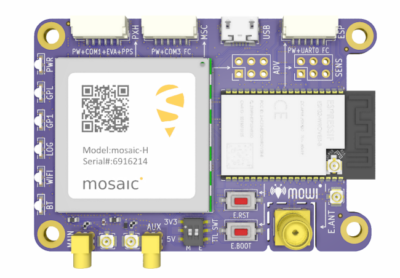mowi, is an open-source reference design for Septentrio’s highly accurate GNSS module, mosaic. It offers Wi-Fi and Bluetooth communication which can easily be programmed for custom applications.
 Leuven, Belgium – September 9, 2021 – Septentrio, a leader in high-precision GNSS* positioning solutions, announces today an important addition to the open-source resources for their GPS/GNSS module receivers: mosaicTM wireless or simply mowi. It combines the Septentrio mosaic-X5 or mosaic-H module receiver with a dual-mode Bluetooth and integrated Wi-Fi from the well-known ESP32- WRover programmable module by Espressif Systems. It is an addition to the already existing mosaicHAT board, designed on the Raspberry Pi platform.
Leuven, Belgium – September 9, 2021 – Septentrio, a leader in high-precision GNSS* positioning solutions, announces today an important addition to the open-source resources for their GPS/GNSS module receivers: mosaicTM wireless or simply mowi. It combines the Septentrio mosaic-X5 or mosaic-H module receiver with a dual-mode Bluetooth and integrated Wi-Fi from the well-known ESP32- WRover programmable module by Espressif Systems. It is an addition to the already existing mosaicHAT board, designed on the Raspberry Pi platform.
 “We are excited about the mowi project being part of the GitHub and prototyping community. The project is available as open-source, thus empowering the community to easily fit autonomous or robotic systems with communication and highly accurate and reliable GNSS positioning technology. mowi empowers the native ethernet features of the mosaic module. The perfect tool for fast prototyping and developing proof-of-concept projects in a simple and connected way,” notes Gustavo Lopez, Market Access Manager at Septentrio. The mowi project facilitates accurate and reliable GNSS positioning for robotic and autonomous devices, on a hardware level. Numerous engineers today use the ESP32 and the multiple libraries available for Internet-of-Things (IoT) prototyping. The mowi board is an easy way for integrators to get started with Septentrio’s mosaic-X5 or mosaic-H heading module receivers. The mowi board can be used on its own or plugged into a mobile computer such as Raspberry Pi or Arduino to deliver high-accuracy positioning with high update rates, ideal for machine navigation, monitoring or control. The internet connection via Wi-Fi or Bluetooth enables numerous industrial IoT applications, simplifying the connectivity to mobile data for the delivery of GNSS corrections needed for cm-level RTK positioning.
“We are excited about the mowi project being part of the GitHub and prototyping community. The project is available as open-source, thus empowering the community to easily fit autonomous or robotic systems with communication and highly accurate and reliable GNSS positioning technology. mowi empowers the native ethernet features of the mosaic module. The perfect tool for fast prototyping and developing proof-of-concept projects in a simple and connected way,” notes Gustavo Lopez, Market Access Manager at Septentrio. The mowi project facilitates accurate and reliable GNSS positioning for robotic and autonomous devices, on a hardware level. Numerous engineers today use the ESP32 and the multiple libraries available for Internet-of-Things (IoT) prototyping. The mowi board is an easy way for integrators to get started with Septentrio’s mosaic-X5 or mosaic-H heading module receivers. The mowi board can be used on its own or plugged into a mobile computer such as Raspberry Pi or Arduino to deliver high-accuracy positioning with high update rates, ideal for machine navigation, monitoring or control. The internet connection via Wi-Fi or Bluetooth enables numerous industrial IoT applications, simplifying the connectivity to mobile data for the delivery of GNSS corrections needed for cm-level RTK positioning.
On top of the wireless communication, the small 47.5×70 mm board can host IoT applications in its internal memory. It has onboard logging and exposes interfaces such as USB, serial communication, and general-purpose pins. The schematic’s reference design, PCB layout and documentation are openly available for prototyping or further customization.
The mowi open-source project is available to the community on the Septentrio GitHub repository. For more information on Septentrio’s industry-leading GNSS receivers, please visit septentrio.com.
Espressif is a trademark of Espressif Systems and Raspberry Pi is a trademark of the Raspberry Pi organization.
* Global Navigation Satellite System including the American GPS, European Galileo, Russian GLONASS, Chinese BeiDou, Japan’s QZSS and India’s NavIC. These satellite constellations broadcast positioning information to receivers which use it to calculate their absolute position.
About Septentrio
Septentrio designs and manufactures multi-frequency multi-constellation GPS/GNSS positioning technology for demanding applications. Reliable centimeter-level positioning enables machine automation improving efficiency and safety. Septentrio provides positioning solutions for industrial applications such as robotics, construction, survey and mapping, maritime, logistics and unmanned aerial vehicles (UAVs). Septentrio has its headquarters in Leuven, Belgium and has a world-wide presence with offices in Los Angeles, Shanghai, Seoul and Yokohama as well as numerous partners around the world. To learn more about Septentrio and its products, visit septentrio.com.
